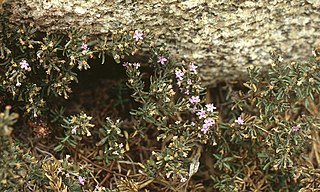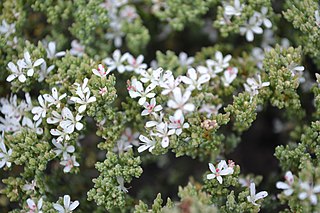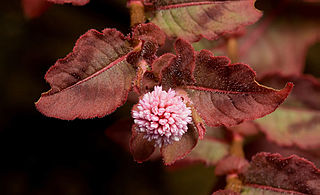
Kunzea is a genus of plants in the family Myrtaceae and is endemic to Australasia. They are shrubs, sometimes small trees and usually have small, crowded, rather aromatic leaves. The flowers are similar to those of plants in the genus Leptospermum but differ in having stamens that are longer than the petals. Most kunzeas are endemic to Western Australia but a few occur in eastern Australia and a few are found in New Zealand. The taxonomy of the genus is not settled and is complicated by the existence of a number of hybrids.

Frankenia salina, often called alkali heath or alkali seaheath, is a perennial herb native to California, Nevada, Mexico and Chile. It is uncommon even in the region where it is most likely to be found, just north of the San Francisco Bay Area.

Hyptis is a genus of flowering plant in the family Lamiaceae. These plants, known commonly as bushmints, are widespread in tropical North and South America, as well as parts of West Africa. There are 150 species, which may be annual or perennial herb to shrub. Recently, several genera were segregated from Hyptis.

Frankenia portulacifolia, also called Saint Helena tea or tea plant, is a species of salt-tolerant plant in the Frankeniaceae family. It is endemic to the islands of Saint Helena, Ascension and Tristan da Cunha. Its natural habitats are inhospitable, dry and rocky areas and rocky shores, often on weathered volcanic ash. As its total population has been estimated at only around 3,500 individuals, it is currently classified as Critically Endangered by the IUCN.

Themeda is a genus of plants in the grass family native to Asia, Africa, Australia, and Papuasia. There are about 18 to 26 species, many of which are native to Southeast Asia.

Frankenia pauciflora, the common sea-heath or southern sea-heath, is an evergreen shrub native to southern Australia. It is part of the Frankenia genus of the Frankeniaceae family.

Frankenia palmeri is a species of flowering plant in the frankenia family, Frankeniaceae, known by the common name Palmer's seaheath, Palmer's frankenia, or yerba reuma. It is native to the coastline of northwestern Mexico, as well as San Diego County, California, in the United States. It is a plant of sand dunes, beaches, alkali flats, and salt marshes, where it thrives due to its adaptation to saline soils. This is a small, tangling shrub less than a meter tall with spreading stems lined with clusters of knobby, fleshy leaves. Toward the ends of branches flowers appear among the leaf clusters. Each flower has white petals 3 or 4 millimeters long, often washed with pink toward the throat and with pink anthers. The plant is becoming increasingly rare as its habitat on valuable coastal land is consumed for development.

Persicaria capitata, the pink-headed persicaria, pinkhead smartweed, pink knotweed, Japanese knotweed, or pink bubble persicaria, is an Asian species of plants in the genus Persicaria within the buckwheat family. It is native to Asia and grown as an ornamental in other countries. It has become naturalized in Australia, South Africa and a few scattered locations in the United States.

Kunzea capitata is a shrub species in the family Myrtaceae. It is native to New South Wales in Australia.

Butia capitata, also known as jelly palm, is a Butia palm native to the states of Minas Gerais and Goiás in Brazil. It is known locally as coquinho-azedo or butiá in (northern) Minas Gerais. This palm grows up to 8m. It has feather palm pinnate leaves that arch inwards towards a thick stout trunk.

Frankenia johnstonii is a species of flowering plant known by the common name Johnston's seaheath, or Johnston's frankenia. It is native to southern Texas in the United States and northern Nuevo León in Mexico, where there are about 30 occurrences known. The plant was federally listed as an endangered species in the United States in 1984. It was found to be more abundant than previously thought and it was proposed for delisting in 2003.

Frankenia is the only genus in the Frankeniaceae family of flowering plants. Other genera have been recognized within the family, such as Anthobryum, Hypericopsis and Niederleinia, but molecular phylogenetic studies have consistently shown that they all belong inside Frankenia. Frankenia comprises about 70–80 species of shrubs, subshrubs and herbaceous plants, adapted to saline and dry environments throughout temperate and subtropical regions. A few species are in cultivation as ornamental plants.

Lespedeza capitata is a species of flowering plant in the Fabaceae, or legume family, and is known by the common name roundhead bushclover, or roundhead lespedeza. It is native to eastern North America, including eastern Canada and the eastern half of the United States.

Frankenia laevis, commonly sea heath, is a low shrub in the family Frankeniaceae. It is native to south-west Europe and Britain and to northwestern Africa, including Macaronesia. It grows on the coast. It is rare in the Britain.

Hyptis capitata, also known as false ironwort or knobweed, is a species of erect annual shrubs, of the plant family Lamiaceae. It is native to Florida, Mexico, Central America, the West Indies, and South America but naturalized in Australia, Southeast Asia, and some tropical islands. The plants grow up to a height of 1.5 meters. Crushed leaves are applied to cuts. It is considered a weed in many places.
Buchenavia capitata is a tree of the Caribbean and northeastern South-American regions. Its Spanish vernacular names include granadillo, almendro (Colombia), amarillo and olivo negro (Venezuela), and mirindiba and periquiteira (Brazil). Its English vernacular name is fourleaf buchenavia. It is also known as Buchenavia tetraphylla (Aubl.) Howard.

Phaleria capitata grows as a shrub or small tree up to 10 metres (30 ft) tall, with a stem diameter of up to 15 centimetres (6 in). Twigs are reddish brown. Inflorescences usually bear five flowers. The fruits are roundish, up to 1.5 cm (1 in) long. Habitat is forest from sea-level to 1,200 metres (3,900 ft) altitude. P. capitata grows naturally in Sri Lanka, Peninsular Malaysia, Sumatra, Borneo, Sulawesi, Maluku, the Philippines, New Guinea, the Caroline Islands and Tonga.

Cap Island Conservation Park is a protected area in the Australian state of South Australia located about 7.5 kilometres (4.7 mi) offshore, west of Mount Misery, Eyre Peninsula. The park covers Cap Island's 8ha surface. The island consists of a granite base and a calcarenite mantle; its margins steeply over-hanging and eroded. Typical vegetation is a low Nitre Bush shrubland. Cap Island Conservation Park was constituted by statute in 1972 to conserve a sea bird breeding area and Australian Sea-lion and New Zealand Fur-seal haul-out areas.
Common sea-heath is a common name for several plants and may refer to:
Thelasis capitata, commonly known as the conical fly orchid, is a plant in the orchid family. It is a clump-forming epiphyte with flattened pseudobulbs, each with a single strap-shaped leaf. A large number of small yellowish green flowers are arranged in a cone shape on a thin but stiff flowering stem. This orchid is found from Thailand to Malesia, including on Christmas Island.
















